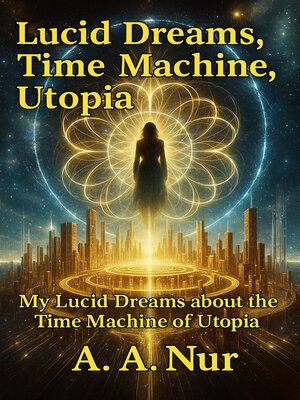Lucid Dreams, Time Machine, Utopia
ebook ∣ My Lucid Dreams about the Time Machine of Utopia
By A. A. Nur

Sign up to save your library
With an OverDrive account, you can save your favorite libraries for at-a-glance information about availability. Find out more about OverDrive accounts.
Find this title in Libby, the library reading app by OverDrive.



Search for a digital library with this title
Title found at these libraries:
| Library Name | Distance |
|---|---|
| Loading... |
This book chronicles the contacts between a 20th-century person—the contactee—and a time traveler from the 89th century. The contactee reports astonishing "future science" information received from the traveler. The book is organized chronologically and presents the information received during each contact. That said, the book also reveals a deeply human relationship between the contactee and the traveler, offering moments of tenderness, doubt, and hope.
The information on "future science" is presented in plain language. Given the book's unusual content and style, dear reader, you should check whether it aligns with your preferences. Please take a moment to read the Table of Contents (located above the prologue) to see the chapter titles, which provide an excellent overview of the book's content. Additionally, here are some of the mysterious ideas presented in the book:
Future scientists prove that the "bootstrap paradox" is part of the real world and necessary for certain phenomena to exist. For example, they demonstrate that life could not have emerged on Earth billions of years ago from lifeless matter—and nowhere else in the Universe. The first cell was sent into the past by 89th-century scientists using a time machine. (2nd contact)
In 2050, scientists in Switzerland conduct a groundbreaking experiment involving the measurement of the mass of a person undergoing assisted suicide with barbiturates. The dying person is placed within a closed system. This system is placed on a digital scale that takes continuous readings every 30 seconds. The scale's readings indicate a mass reduction of 1.5 grams at the moment of death. In other words, they discover that consciousness has mass. (5th contact)
The traveler explains a forgotten teaching of the Buddha and introduces advanced machines designed to aid lucid dreamers and meditators—showing a deep convergence between ancient wisdom and future technology. These machines function as follows: as soon as the meditator begins to daydream, his eyes start to move. The machine detects REM and sends a signal to the meditator. The signal – such as a flash of light – awakens the meditator from his daydreaming, who returns his attention to breathing. The same machine can help a person meditate during the daytime and experience lucid dreams at night. (8th contact)
The "paradox of suffering in logic" is this: without suffering, the concepts of 'truth' and 'falsehood' have no meaning—thus, logic cannot exist. Yet textbooks on logic do not mention suffering, as if suffering is irrelevant to logic, or as if suffering does not exist. (19th contact)
20th-century physics accounts for physical quantities like time, mass, temperature, and many others, which can be measured by instruments and appear as variables in equations. However, suffering isn't considered a physical quantity; physicists can't measure it, and it doesn't appear in equations. From the perspective of future physics, suffering is a physical quantity. It can be measured by instruments and appears as a variable in equations." (20th contact)
By the year 2905, scientists develop a theory capable of predicting whether a system is conscious or not. The system can be a human, a machine, or even a brick. The theory requires input data about the system's physical and chemical properties. The theory correctly predicts that a brick is not conscious, that a human is conscious, and that systems made of transistors—like the electronic computers of your...







